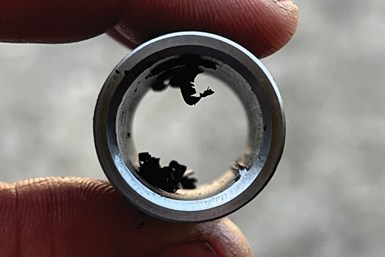Craftsman Cribsheet No. 119: Defeating the Hanging Cross-Hole Burr
Deburring is a tedious task that is better left to machines.
#pmpa
Anyone who has ever drilled a cross-hole knows about burrs. Especially when going through the wall of a through-hole. It’s even worse when you are drilling some welded tubing. How do we get rid of these? What are ways we can eliminate or reduce second operations on parts like this?
Running Parts on a Mill-Turn or Swiss-Type Lathe
Run a wire brush or ceramic ball brush through the ID after cross holing. This will break small burrs and hairs off the ID. It will also cause a small radius to form on the ID of the cross-hole as it passes through. The brush needs to be slightly larger than your ID so that the brush will be putting pressure into the cross-hole as it passes by. Not reliable enough in higher volumes.
Featured Content
Back chamfering tool from an additional live spindle. Using a back chamfering tool lets you get a consistent chamfer on the ID of the back side of the cross-hole clearing the burr. It allows for consistent processing but can be time-consuming. If you have customer requirements for chamfers on the back side of the cross-hole in the ID, a back chamfering tool is one of the few ways to get that chamfer right.
Running Parts on Traditional Turning or Screw Machines
Mass finishing — tumbling parts with appropriate media. You must be careful of media selection when vibratory finishing cross-holes. You want media that is shaped so that it properly clears your burr but does not get stuck in the ID of your part or the cross-hole itself. Always do a test run of a small batch of parts to check a media’s fitness for use. Mass finishing does not work well on tough thick burrs.
Thermal deburring. Thermal deburring, sometimes called flash deburring, involves the application of intense heat over a brief period effectively incinerating the burr. Thermal deburring works great on small hair-like burrs that are typically seen in threading. It is much less effective on larger burrs that have large attachment points to the raw material. There are many outside vendors that provide thermal
deburring services.
Boring to size. If you have the tolerance or are drilling from solid bar, then boring to size after the cross-hole is a great method. Run your hole size a little smaller, then bore to size after completing cross drilling operations. This allows the boring bar to take out the burrs as it passes through
the hole.
In a traditional three-axis CNC mill your options are more limited because you don’t have the part clamped in a collet with rotational capabilities. Mass finishing, thermal deburring or back chamfering are the best approaches.
Deburring is an essential part of our everyday life in the shop. Finding automated methods to eliminate burrs is efficient, places a tedious task on machines and leaves your performers available for more important tasks. The key is understanding techniques to properly handle burrs. Dropping parts off complete and burr-free not only frees up your performers time for their highest and best use, it reduces hassle in your downstream processes.
About the Author

David Wynn
David Wynn, MBA, is the PMPA Technical Services Manager with over 20 years of experience in the areas of manufacturing, quality, ownership, IT and economics. Email: dwynn@pmpa.org — Website: pmpa.org.
RELATED CONTENT
-
Reaming as an Alternative to Single-Point Boring
Using slip yokes as an example, reaming through holes can be more efficient and effective than single-point boring operations.
-
Video Tech Brief: Live-Tool, Y-Axis CNC Lathe with a Compact Footprint
This small footprint, big-bore lathe offers a generous work envelope. The addition of Y-axis and live tooling enables milling, drilling and tapping for increased machine capabilities.
-
Addressing Micro-Boring Challenges
This boring bar/tool holding system for Swiss-type lathes is said to offer high rigidity and positioning repeatability. In addition, the boring bars can be changed out using no hand tools.






